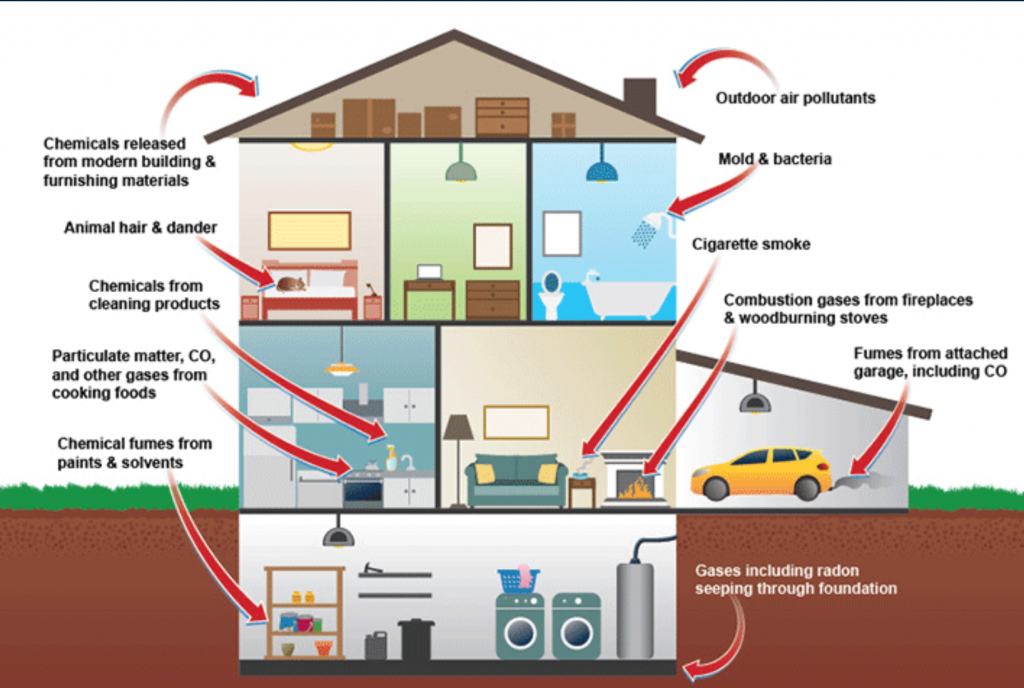Here what you need to know about Indoor Air Quality
admin May 30, 2023 0
The importance of Indoor air quality
Indoor air quality (IAQ) refers to the quality of the air inside a home, school, office, or other building. It is important because people spend most of their time indoors, and indoor air can be more polluted than outdoor air.
There are many sources of indoor air pollution, including:
- Combustion byproducts, such as carbon monoxide, particulate matter, and environmental tobacco smoke.
- Substances of natural origin, such as radon, pet dander, and mold.
- Biological agents, such as molds.
- Pesticides, lead, and asbestos.
- Ozone (from some air cleaners).
- Volatile organic compounds (VOCs) from a variety of products and materials.
Most pollutants affecting IAQ come from sources inside buildings, although some originate outdoors.
Indoor sources of pollutants include:
- Combustion sources, such as tobacco smoke, wood and coal heating and cooking appliances, and fireplaces.
- Cleaning supplies, paints, insecticides, and other commonly used products.
- Building materials, whether through degrading materials or from new materials.
- Natural substances, such as radon, mold, and pet dander.
Outdoor sources of pollutants include:
- Outdoor air pollutants from cars, trucks, factories and other sources that enter buildings through open doors, windows, ventilation systems, and cracks in structures.
- Radon that forms in the ground and enters buildings through cracks or gaps in structures.
- Volatile chemicals in water supplies that enter indoor air when building occupants use the water.
- Soils and dusts that people bring into buildings on their shoes and clothing.
Health effects associated with IAQ pollutants include:
- Irritation of the eyes, nose, and throat.
- Headaches, dizziness, and fatigue.
- Respiratory diseases
- Heart disease and cancer.
The link between some common indoor air pollutants and health effects is very well established. For example, radon is a known human carcinogen and is the second leading cause of lung cancer. Carbon monoxide is toxic, and short-term exposure to elevated carbon monoxide levels in indoor settings can be lethal. Episodes of Legionnaires’ disease, a form of pneumonia caused by exposure to the Legionella bacterium, have been associated with buildings with poorly maintained air conditioning or heating systems. Numerous indoor air pollutants—dust mites, mold, pet dander, environmental tobacco smoke, cockroach allergens, particulate matter, and others—are “asthma triggers,” meaning that some asthmatics might experience asthma attacks following exposure.
While adverse health effects have been attributed to some specific pollutants, the scientific understanding of some IAQ issues continues to evolve. For example, “sick building syndrome” is a condition in which building occupants experience similar symptoms after entering a particular building, with symptoms diminishing or disappearing after they leave the building. These symptoms are increasingly being attributed to a variety of building indoor air attributes.
Researchers also have been investigating the relationship between IAQ and important issues not traditionally thought of as related to health, such as student performance in the classroom and productivity in occupational settings.
Though much is known about the broad range of IAQ issues and associated health effects, currently only two national indicators of IAQ are available based on long-term and quality data: Radon and Serum Cotinine (a measure of exposure to tobacco smoke).
There are a number of things that can be done to improve IAQ, including:
- Ventilation: Make sure that there is adequate ventilation in your home or office. This can be done by opening windows and doors, using fans and dehumidifier.
- Cleaning: Regularly clean your home or office to remove dust, dirt, and other pollutants.
- Avoiding smoking: Smoking is a major source of indoor air pollution. If you smoke, don’t smoke indoors.
- Using less harsh cleaning products: Avoid using harsh cleaning products that can release harmful chemicals into the air, here some eco-friendly alternative
- Getting rid of clutter: Clutter can trap dust and other pollutants. Get rid of clutter to improve IAQ.
- Getting an air purifier: An air purifier can help to remove pollutants from the air.
- Have plenty of plants in your home ti increase the quality of the air, here a list of best indoor plants
If you are concerned about IAQ, you can talk to your doctor or a qualified IAQ professional. They can help you to assess your IAQ and recommend steps that you can take to improve it.





